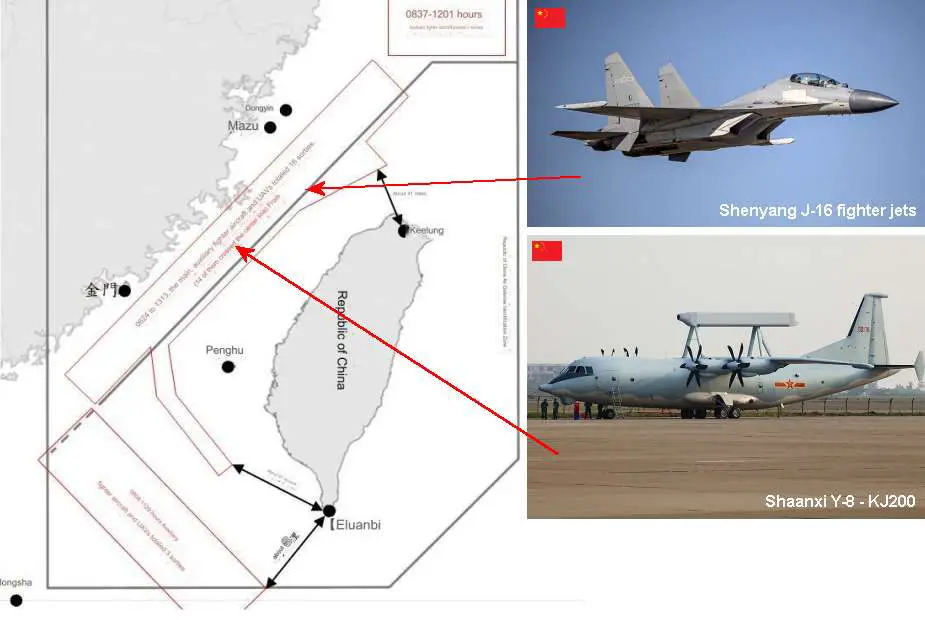17 Chinese Combat Aircraft and 7 Vessels Enter Taiwan's Air Defense Identification Zones
The Taiwanese Ministry of Defense reported on April 21, 2024, that 21 aircraft and 7 naval vessels of the Chinese armed forces were detected operating around Taiwan until 6 a.m. (UTC+8). Notably, 17 of these aircraft crossed the median line of the Taiwan Strait, entering Taiwan's northern and southwestern Air Defense Identification Zones (ADIZ).
Follow Army Recognition on Google News at this link

Map published by the Taiwanese Ministry of Defense illustrating the incursion of Chinese armed forces' aircraft into areas near Taiwan, April 21, 2024. (Picture source Taiwanese MoD)
This boundary, traditionally seen as a tacit border, has seen increased violations by Chinese military assets, a trend that began escalating significantly after former US House Speaker Nancy Pelosi's visit to Taiwan in August 2022. Pelosi's visit marked the highest-level US official to set foot in Taiwan in nearly three decades, sparking a sharp increase in military tensions.
According to reports from the "Taiwan News," the Chinese presence included advanced Shenyang J-16 fighter jets, Shaanxi Y-8 transport aircraft, and various unmanned aerial vehicles (UAVs), beginning their operations at 8:15 am on Sunday. This month alone, Taiwan has tracked Chinese military aircraft on 193 occasions and naval vessels 125 times.
The surge in such activities is part of China's broader "gray zone" tactics, which involve incremental increases in military presence around Taiwan, intended to pressure the island without triggering an outright conflict. These tactics have been notably more aggressive since September 2020.
In response to these provocations, Taiwan has mobilized its own air and naval forces and activated air defense missile systems to monitor and respond to activities by the People's Liberation Army (PLA Chinese armed forces). This ongoing military pressure underscores the fragile security situation in the Taiwan Strait, which remains one of the most sensitive geopolitical flashpoints in the Asia-Pacific region.
As of early 2024, tensions between Taiwan and China remain elevated, primarily driven by China's dissatisfaction with Taiwan's political developments and its ongoing pressure tactics, including military incursions near Taiwan.
Following Taiwan's presidential election in January, Beijing has been intensifying its efforts to assert pressure on Taiwan's newly elected president, William Lai, by employing various methods that range from diplomatic and legal maneuvers to more coercive military actions. This strategy includes significant military activities such as near-daily flights of Chinese military aircraft near or across the median line of the Taiwan Strait, as well as maritime operations close to Taiwan's waters.
Recent weeks have seen an uptick in Chinese military activities around Taiwan. For instance, the People’s Liberation Army (PLA) conducted 225 sorties into Taiwan’s Air Defense Identification Zone (ADIZ) over a month, a noticeable increase in frequency which highlights the ongoing military pressure from Beijing.
Taiwan, in response, has bolstered its defense capabilities, focusing on asymmetric warfare strategies that aim to make any potential military assault costly for the PLA. This includes extensive purchases of military equipment from the United States, enhancements to its missile systems, and reforms in military conscription and reserve systems.
Furthermore, in the broader geopolitical context, actions and reactions surrounding Taiwan are also influenced by the United States, which continues to play a significant role in the region by supporting Taiwan militarily and diplomatically.
Defense News April 2024
- Hits: 2364
















